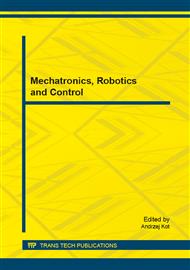p.1
p.15
p.27
p.37
p.45
p.51
p.59
p.71
Magnetic Field Analysis of the Actuator in a Semi-Active Vibration Control of the Beam with MR Fluid
Abstract:
In this study the analysis of the magnetic field distribution of an electromagnet is presented. This electromagnet is used as an actuator in a semi-active vibration control of the three-layer beam with MR fluid. Two separate numerical methods are used for the purpose of calculating the magnetic field distribution. The first method is based on the Finite Element Method and implemented using ANSYS software. The second, simplified one is based on the assumption that the electromagnet can be substituted by a simple magnetic circuit divided into separate paths, with each sub-path defined by the value of reluctance of the corresponding electromagnet part. The comparison of the results from both methods with the ones obtained from an experiment is also presented and analyzed in the paper.
Info:
Periodical:
Pages:
37-44
Citation:
Online since:
May 2015
Authors:
Keywords:
Price:
Сopyright:
© 2015 Trans Tech Publications Ltd. All Rights Reserved
Share:
Citation:


